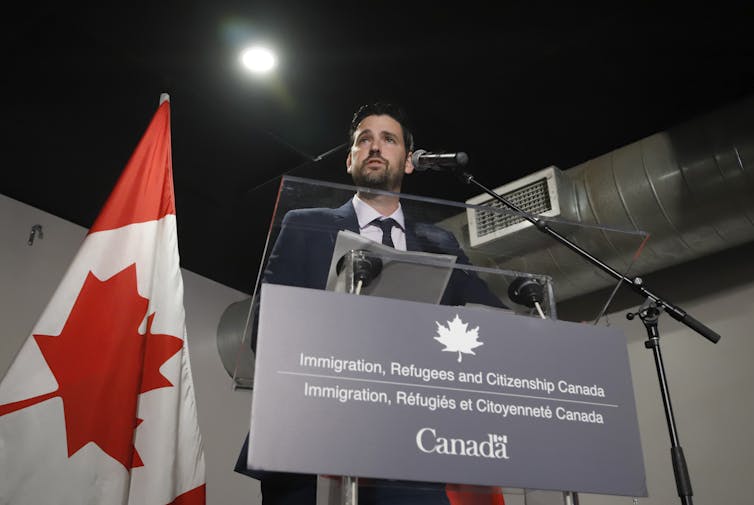Rupa Banerjee, Toronto Metropolitan University
Immigration is largely accepted as one of the best strategic responses to Canada’s declining birth rates, aging population and labour market shortages. In many ways, immigrants are now positioned to be the saviours of Canada’s post-pandemic recovery.
Even with steadily rising numbers and the challenges brought on by the COVID-19 pandemic, Canadians are more favourable towards immigration than ever before.
Canada’s new immigration targets are unprecedented — more than 1.4 million new permanent residents will be admitted by 2025. Setting targets, however, is the easy part. More difficult is ensuring Canada is up to the task of selecting and welcoming the influx of newcomers that will be arriving over the next few years.
But if immigrants are going to be a panacea for our demographic and economic challenges, they must be able to find skills-appropriate employment and settle into communities. Selecting the right mix of newcomers is the first crucial element to consider.
Barriers for immigrant workers
Employers across Canada have reported labour shortages in a range of skill levels and sectors, including accommodation, food services, skilled trades and health care.
The current economic immigrant selection system, Express Entry, prioritizes “high-skilled” immigrants — those with post-secondary education — in fields like information technology and finance. However, many of these individuals face significant underemployment, with foreign credentials discounted and the requirement to have Canadian experience preventing many from finding skills-appropriate work.
The new immigration plan will expand the eligible skill levels and ease access to permanent resident status for essential workers who were previously excluded from the selection system, like transport truck drivers, nurse assistants and heavy equipment operators.

Although this is a positive development, it is an open question whether so-called “lower-skilled” newcomers — those without post-secondary education — will find work and stay in their intended occupations. Canada’s focus on high-skilled immigration thus far has been based on research that shows that higher-skilled newcomers have better labour market outcomes in the long term than those with lower skills.
In general, less educated workers tend to be more susceptible to unemployment and poverty.
However, given the rampant devaluation of foreign credentials and the oversupply of high-skilled workers, it is possible that lower-skilled immigrants in essential sectors will actually face less relative labour market disparity than their high-skilled counterparts.
Changes to Express Entry
Another significant change is the introduction of targeted invitations within Express Entry. Currently, Express Entry applicants are evaluated by a comprehensive ranking system. Candidates that meet a certain cutoff score are invited to apply in biweekly draws.
Applicants know their chance of being invited based on their ranking system score. However, with targeted invitations, it will be up to Immigration, Refugees and Citizenship Canada to determine which characteristics are valued in each draw. This adds significant uncertainty for applicants who may be overlooked even with a high ranking system score.
Government officials have stated that targeted draws will allow for the prioritization of high demand occupations. While occupation-specific admission has the advantage of potentially addressing talent shortages in certain fields, it may also result in an oversupply of workers in some areas.
If labour demand shifts due to economic downturn, these workers may be left out in the cold, as was the case for tech workers after the dot-com bubble burst in the early 2000s.
Investing in supports
For the immigration plan to be successful, the selection system is just one side of the equation. The government must also invest in the infrastructure needed to accommodate the population growth, including affordable housing, access to health care and schooling supports.

Labour market integration policies and practices are equally important to ensure that immigrants’ skills are recognized and properly utilized. For example, immigrants trained in regulated occupations, like nursing, struggle to enter their professions, even though many of these fields have severe labour shortages.
Although several provinces now have fairness commissioners whose mandate is to enhance transparency in occupational licensing processes, significant barriers remain.
The experience is not much better for immigrants seeking employment in unregulated fields. Currently, the burden of integration is placed disproportionately on individual immigrants themselves. However, all stakeholders — including policymakers, occupational regulatory bodies, educational institutions and employers — should play a role in this process.
Everyone has a role to play
Settlement services and occupationally relevant language training must be made more accessible for newcomers with lower levels of education, since official language fluency is among the most important determinants of success and lower-skilled immigrants tend to be less fluent.
It is also more crucial than ever before to implement active labour market policies (ALMPs) that prioritize upskilling, reskilling and on-the-job training for essential workers.
Lastly, employer engagement is vital. Although Canadian employers demand more immigration, they tend not to hire permanent immigrants into high quality positions. Instead, they often prefer to recruit temporary foreign workers into low wage, precarious roles.
This is short sighted, particularly in a labour shortage, since decent working conditions and fair treatment improve productivity and competitiveness. Employers should work with immigrant-serving organizations, like the Toronto Region Immigrant Employment Council, to better understand foreign qualifications and experience so they can leverage the skills of immigrant workers more effectively.
Finally, it is important for managers and other decision-makers to recognize unconscious bias and improve their own intercultural competence. Without the active participation of employers, even the most enlightened selection policies will fall flat. Canadians currently have a positive view of immigration, and we are seen as a global leader, but there is no guarantee that this will remain if immigrant integration isn’t adequately supported.![]()
Rupa Banerjee, Canada Research Chair and Associate Professor of Human Resource Management and Organizational Behaviour, Toronto Metropolitan University
This article is republished from The Conversation under a Creative Commons license. Read the original article.


